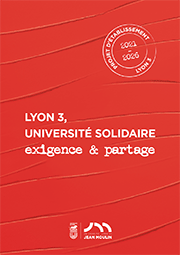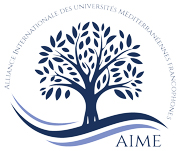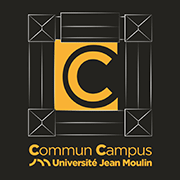AccueilRechercheProgrammes et productions scientifiquesThèsesThèses soutenuesThèses soutenues - 2006-2021Thèses soutenues - 2012
-
Partager cette page
- Recherche,
SOTO Didier
Analyse géographique des changements climatiques des surfaces continentales de l’espace Nord-Atlantique pendant le Tardiglaciaire Würmien
Publié le 4 janvier 2013 – Mis à jour le 7 janvier 2013
Thèse en Géographie aménagement le 3 décembre 2012
Cette thèse propose une analyse multicritères de 686 sites d’étude, à partir de laquelle sont géovisualisées les caractéristiques bioclimatiques des stades et interstades du Tardiglaciaire. La cartographie des données obtenues, principalement gr?ce au croisement de trois méthodes de quantification, permet d’opposer plusieurs domaines paléoclimatiques distincts au sein de l’aire d’étude. Le synchronisme relatif des géochronologies étudiées met en avant la position centrale de l’Océan Atlantique Nord dans la détermination des changements climatiques abrupts de la période. Toutefois, le réexamen des principaux scénarii de for?age océanique révèle certaines de leurs limites en ce qui concerne le déclenchement, l’auto-entretien et la téléconnexion du signal climatique. En revanche, l’exploration d’autres mécanismes physiques permet de valider l’hypothèse selon laquelle la dynamique des masses d’air est une composante essentielle dans le for?age des changements climatiques du Tardiglaciaire. Cependant, le modèle théorique usuel de circulation atmosphérique ne permet pas de reconstituer avec précision la dynamique paléoclimatique. Une des principales innovations de cette thèse est donc de proposer l’expérimentation d’un modèle de circulation générale, celui de l’Anticyclone Mobile Polaire (AMP), qui permet une explication globale des changements climatiques par la détermination de deux modes distincts de circulation aérologique (rapide et semi-rapide). L’avantage de ce modèle réside dans sa capacité à analyser de manière pertinente la diversité des évolutions paléoenvironnementales sur l’aire d’étude.
This thesis proposes a multi-criterion analysis, from which have been displayed the bioclimatic characteristics of the Late-Glacial stadials and interstadials. Mapping data, mainly obtained through crossing three quantification methods, lead to the opposition of distinct paleoclimatic domains in the study area. The relative synchronism of the studied geochronologies highlights the central position of the Northern Atlantic Ocean in the determination of Late-Glacial abrupt climatic changes. However, a review of the main scenarios of oceanographic forcing identifies some of their limitations in the triggering, self-maintenance as well as the teleconnection of the climatic signal. The exploration of other physical mechanisms allows validating the hypothesis by which the air masses’dynamic is an essential component in the forcing of abrupt climatic events. However, the usual theoretical model of atmospheric circulation can not accurately reconstruct the paleoclimatic dynamic of Late-Glacial events. One of the main innovations of this thesis is therefore to experiment a general circulation model, the Mobile Polar High’s one, which provides a comprehensive explanation of climate changes by determining two distinct modes of aerologic circulation (fast and semi-fast). The advantage of this model lies in its ability to analyze a relevant diversity of paleoenvironmental changes in North America and Eurasia during the study period.
Mots-clés : changements climatiques, Tardiglaciaire würmien, espace Nord-Atlantique, dynamique des masses d’air, paléoenvironnements, quantifications thermiques, SIG.
Key words : climate changes, Weichselian Late-Glacial, North Atlantic area, air masses ‘dynamic, paleoenvironments, thermal quantifications, GIS.
Directeur de thèse : Jacques COMBY
Membres du jury :
Jean-Pierre VIGNEAU, Professeur émérite, Université de Paris-Ouest
Hervé CUBIZOLLE, Professeur, Université de Saint Etienne
Anne-Marie LEZINE, Directeur de recherche au CNRS, LSCE à Gif-sur-Yvette
Luc BARTHELEMY, Ma?tre de conférences, Université Jean Moulin Lyon 3
Willem HOEK, Professeur, Université d’Utrecht
Jacques COMBY, Professeur, Université Jean Moulin Lyon 3
Président du jury : Anne-Marie LEZINE
Mention : Très honorable
Equipe d'accueil : CRGA
This thesis proposes a multi-criterion analysis, from which have been displayed the bioclimatic characteristics of the Late-Glacial stadials and interstadials. Mapping data, mainly obtained through crossing three quantification methods, lead to the opposition of distinct paleoclimatic domains in the study area. The relative synchronism of the studied geochronologies highlights the central position of the Northern Atlantic Ocean in the determination of Late-Glacial abrupt climatic changes. However, a review of the main scenarios of oceanographic forcing identifies some of their limitations in the triggering, self-maintenance as well as the teleconnection of the climatic signal. The exploration of other physical mechanisms allows validating the hypothesis by which the air masses’dynamic is an essential component in the forcing of abrupt climatic events. However, the usual theoretical model of atmospheric circulation can not accurately reconstruct the paleoclimatic dynamic of Late-Glacial events. One of the main innovations of this thesis is therefore to experiment a general circulation model, the Mobile Polar High’s one, which provides a comprehensive explanation of climate changes by determining two distinct modes of aerologic circulation (fast and semi-fast). The advantage of this model lies in its ability to analyze a relevant diversity of paleoenvironmental changes in North America and Eurasia during the study period.
Mots-clés : changements climatiques, Tardiglaciaire würmien, espace Nord-Atlantique, dynamique des masses d’air, paléoenvironnements, quantifications thermiques, SIG.
Key words : climate changes, Weichselian Late-Glacial, North Atlantic area, air masses ‘dynamic, paleoenvironments, thermal quantifications, GIS.
Directeur de thèse : Jacques COMBY
Membres du jury :
Jean-Pierre VIGNEAU, Professeur émérite, Université de Paris-Ouest
Hervé CUBIZOLLE, Professeur, Université de Saint Etienne
Anne-Marie LEZINE, Directeur de recherche au CNRS, LSCE à Gif-sur-Yvette
Luc BARTHELEMY, Ma?tre de conférences, Université Jean Moulin Lyon 3
Willem HOEK, Professeur, Université d’Utrecht
Jacques COMBY, Professeur, Université Jean Moulin Lyon 3
Président du jury : Anne-Marie LEZINE
Mention : Très honorable
Equipe d'accueil : CRGA
Documentation
Mise à jour : 7 janvier 2013







